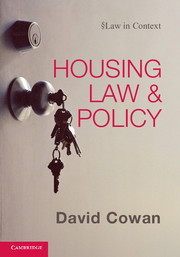Book contents
- Frontmatter
- Contents
- Preface
- List of abbreviations
- Table of legislation
- Table of international instruments
- Table of cases
- 1 Locating housing law and policy
- Part I Regulation of housing tenure
- 2 Regulating ownership
- 3 Regulating private renting
- 4 Regulating local authority housing
- 5 Regulating private registered providers
- Part II Access to housing
- Part III Rights and responsibilities
- Postscript
- Bibliography
- Index
5 - Regulating private registered providers
from Part I - Regulation of housing tenure
Published online by Cambridge University Press: 05 June 2012
- Frontmatter
- Contents
- Preface
- List of abbreviations
- Table of legislation
- Table of international instruments
- Table of cases
- 1 Locating housing law and policy
- Part I Regulation of housing tenure
- 2 Regulating ownership
- 3 Regulating private renting
- 4 Regulating local authority housing
- 5 Regulating private registered providers
- Part II Access to housing
- Part III Rights and responsibilities
- Postscript
- Bibliography
- Index
Summary
In the previous chapter, we considered the reasons for the relative decline of local authority housing. PRPs now occupy centre ground in the development of the social housing sector, despite having had a relatively marginal position in housing policy for the first three-quarters of the twentieth century. Their statistical significance in terms of numbers of properties owned is clear. In 1981, the PRP sector accounted for 498,000 properties against a local authority stock of 6,305,000 (about 7% of the social housing stock). By 31 March 2010, PRPs owned just shy of 2.5 million properties (TSA 2010b), accounting for about 58% of the social housing stock.
This growth is due to a number of policy and fiscal choices concerning the identity of appropriate bodies to develop the social sector. In the previous chapter, it was noted that local authorities were largely regarded as a stop gap, before the private sector took over. The demise of private renting and growth of ownership to levels which were regarded as having reached sustainable limits required an alternative source to be developed in the 1980s. PRPs filled that role, and the reasons why they were chosen are part of the focus of this chapter. Such growth also creates tensions, which are also discussed in this chapter. For PRPs, these tensions include concerns about the independence of the sector, its status as a coherent movement and shifts in the internal understanding of such organisations to enable them to meet the policy challenge. For policy-makers, the tensions concern the regulatory structures of the sector, its affordability both in capital and revenue terms, and the tightrope of controlling the sector while seeking to maintain its independence. This latter point is significant in terms of the shifting identity of the sector on the public–private continuum, which has become a crucial issue not just for regulation, but also for a range of consequential duties and responsibilities (under the HRA and Equality Act 2010).
- Type
- Chapter
- Information
- Housing Law and Policy , pp. 102 - 140Publisher: Cambridge University PressPrint publication year: 2011



